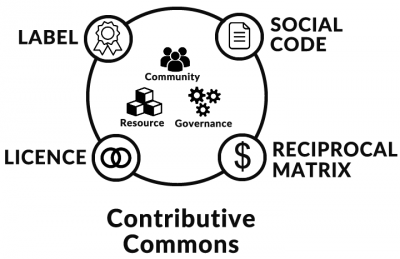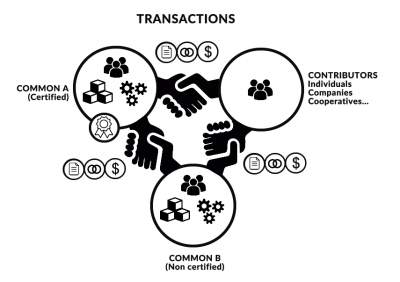Contributive Commons as Tools for Reciprocity: Difference between revisions
Maiadereva (talk | contribs) (Created page with "''This page is a translation of french page Contributive Commons : des outils pour une réciprocité.'' (Feel free to correct the english...) The site [http://contributiv...") |
Maiadereva (talk | contribs) No edit summary |
||
| Line 16: | Line 16: | ||
He has an incentive and pedagogical purpose. | He has an incentive and pedagogical purpose. | ||
It allows the generic definition of the commons (lowest common denominator) | It allows the generic definition of the commons (lowest common denominator) | ||
Examples : [http://movecommons.org/fr/preview/ Move Commons] – [http://unisson.co/tableau-des-ingredients/ Unisson]'' | Examples: [http://movecommons.org/fr/preview/ Move Commons] – [http://unisson.co/tableau-des-ingredients/ Unisson]'' | ||
* '''A Contributive Commons Licnese''' : inspired by Commercial [https://creativecommons.org/ Creative Commons] licenses (CC BY and CC BY SA), it adds conditions to the commercial use of common. | * '''A Contributive Commons Licnese''' : inspired by Commercial [https://creativecommons.org/ Creative Commons] licenses (CC BY and CC BY SA), it adds conditions to the commercial use of common. | ||
''The license defines the general conditions of access and diffusion, but it withdraws the conditions of commercial use in a different document called social code.'' | ''The license defines the general conditions of access and diffusion, but it withdraws the conditions of commercial use in a different document called social code.'' | ||
* '''A Social Code''' : text that defines the bundles of qualities, values, rights and wealth of the common, and contains a reciprocal matrix. | * '''A Social Code''' : text that defines the bundles of qualities, values, rights and wealth of the common, and contains a reciprocal matrix. | ||
''The terms of commercial use and transactions are set by each common and explained through its social code including a reciprocity matrix (which can be considered the equivalent of a commercial contract). | ''The terms of commercial use and transactions are set by each common and explained through its social code including a reciprocity matrix (which can be considered the equivalent of a commercial contract). | ||
Eaemple : [http://semeoz.info/codesocial-de-semeoz/ Social Code of french association Semeoz]'' | Eaemple: [http://semeoz.info/codesocial-de-semeoz/ Social Code of french association Semeoz]'' | ||
* '''A Reciprocity Matrix''' : equivalent to a rate schedule that clearly indicates contributors conditions of payments depending on the use made of the common. This matrix is in the social code. | * '''A Reciprocity Matrix''' : equivalent to a rate schedule that clearly indicates contributors conditions of payments depending on the use made of the common. This matrix is in the social code. | ||
''Examples : [http://freeplaymusic.com/ FreePlayMusic] (23 rates based on the use) – [https://www.loomio.org/d/vU2V5Wi4/r-diger-une-premi-re-version-d-un-contrat-de-r-ciprocit- French reciprocity agreement of a third place]'' | ''Examples: [http://freeplaymusic.com/ FreePlayMusic] (23 rates based on the use) – [https://www.loomio.org/d/vU2V5Wi4/r-diger-une-premi-re-version-d-un-contrat-de-r-ciprocit- French reciprocity agreement of a third place]'' | ||
* '''A money''' : unencrypted and abundant, it is just to clarify the interaction between the labeled commons. | * '''A money''' : unencrypted and abundant, it is just to clarify the interaction between the labeled commons. | ||
''This money, which is not essential to the implementation of the Contributive Commons, would be dedicated to commons exchanges in order to promote the economy of the commons and secure these exchanges compared to the external market. | ''This money, which is not essential to the implementation of the Contributive Commons, would be dedicated to commons exchanges in order to promote the economy of the commons and secure these exchanges compared to the external market. | ||
Examples : Local Exchange Trading Systems, [https://en.wikipedia.org/wiki/WIR_Bank WIR], [http://www.agoravox.fr/actualites/economie/article/pour-un-systeme-monetaire-112936 SME] (balanced monetary union, in French), [http://www.kronos.money/?lang=en KRONOS]'' | Examples: Local Exchange Trading Systems, [https://en.wikipedia.org/wiki/WIR_Bank WIR], [http://www.agoravox.fr/actualites/economie/article/pour-un-systeme-monetaire-112936 SME] (balanced monetary union, in French), [http://www.kronos.money/?lang=en KRONOS]'' | ||
[[File:Contributive-commons-transaction-en.png|400px|thumbnail|left]]'''Principle of inclusion''': any contact being allowed to use the common (including commercial use) is necessarily a '''contributor''' whose contribution is received with '''goodwill''' by the community regardless of the form of this contribution (including whether it is money). | |||
A contributor (individual, company, cooperative, common ...) has not necessarily the label but shall accept in full knowledge the terms of the transaction proposed by the common. | |||
Any user of the common are encouraged to also feel contributor (an expression of gratitude or the payment of a sum of money are contributions). | |||
Each common decides the '''conditions of reciprocity''' it wishes to include in its social code and reciprocal matrix. This allows endless possibilities, depending on the values and objectives of each community. | |||
''Example: a common shares a resource with another accredited common, but requires a financial contribution to a non-accredited contributor.'' | |||
To use the Contribuive Commons License, a common necessarily must have the Contributive Commons Label. | |||
The mention of the Contributive Commons will necessarily be accompanied by a URL link to the Social Code that contains the reciprocal matrix. It can for example be mentioned as follows: | |||
[[File:Contributive-common.jpg|90px|thumbnail]] | |||
« ''This content is under [http://contributivecommons.org/lcc-by-co-sa1/ Contributive Commons License BY – CO – SA]. Please always refer to the [#|terms of commercial use]'' » | |||
This principle requires to establish a '''digital notaries''' guaranteeing the validity of a Social Code on the date of the transaction. | |||
==Commons defined by 4 types of bundles== | |||
Following John Commons and [[Elinor Ostrom]] who defined bundles of rights for commons, the Contributive Commons proposes to extend the principle by defining a common around 4 main bundles: | |||
* '''Bundles of qualities''' : the essence of the common, its social function, the contours of the managed resource | |||
* '''Bundles of values''' : political, moral, social, ecological, artistic values shared by the common | |||
* '''Bundles of rights''' : ownership, access, passage, use, modification, alienation, sharing rules... | |||
* '''Bundles of wealth''' : the payment, transactions, financial management, redistribution, partnerships methods… | |||
[http://contributivecommons.org/des-exemples-de-matrices-a-jardiner-collectivement/ See "Des exemples de matrices à jardiner collectivement" (in French)] | |||
[[Category:Licensing]] | |||
Revision as of 13:56, 9 October 2016
This page is a translation of french page Contributive Commons : des outils pour une réciprocité. (Feel free to correct the english...)
The site Contributive Commons (Facebook Page) comes from an first article of analysis and reflection about [Commons-Based_Reciprocity_Licenses reciprocity licenses] (such as Peer Production License) wrote by Maïa Dereva. This article being very long (15 pages), the site propose short fact sheets to synthesize the key ideas of this proposal.
Key issues:
Synthesis
After analyzing the reciprocity licensing proposals and previous studies on the subject, the conclusion seems to be that a reciprocity license can't reflect alone all the necessary conditions for regulation of commercial transactions from provided that they are authorized for commons. In particular, it seems compromised to draft consensus terms since they are based on moral values.
More than a license, the Contributive Commons propose a set of articulated tools in order to create the conditions for a reciprocal transaction between a common and contributors :

- A Contributive Commons Label which is a peer-to-peer self-agreement.
The is intended for community members who identify as commons. He has an incentive and pedagogical purpose. It allows the generic definition of the commons (lowest common denominator) Examples: Move Commons – Unisson
- A Contributive Commons Licnese : inspired by Commercial Creative Commons licenses (CC BY and CC BY SA), it adds conditions to the commercial use of common.
The license defines the general conditions of access and diffusion, but it withdraws the conditions of commercial use in a different document called social code.
- A Social Code : text that defines the bundles of qualities, values, rights and wealth of the common, and contains a reciprocal matrix.
The terms of commercial use and transactions are set by each common and explained through its social code including a reciprocity matrix (which can be considered the equivalent of a commercial contract). Eaemple: Social Code of french association Semeoz
- A Reciprocity Matrix : equivalent to a rate schedule that clearly indicates contributors conditions of payments depending on the use made of the common. This matrix is in the social code.
Examples: FreePlayMusic (23 rates based on the use) – French reciprocity agreement of a third place
- A money : unencrypted and abundant, it is just to clarify the interaction between the labeled commons.
This money, which is not essential to the implementation of the Contributive Commons, would be dedicated to commons exchanges in order to promote the economy of the commons and secure these exchanges compared to the external market. Examples: Local Exchange Trading Systems, WIR, SME (balanced monetary union, in French), KRONOS

Principle of inclusion: any contact being allowed to use the common (including commercial use) is necessarily a contributor whose contribution is received with goodwill by the community regardless of the form of this contribution (including whether it is money).
A contributor (individual, company, cooperative, common ...) has not necessarily the label but shall accept in full knowledge the terms of the transaction proposed by the common.
Any user of the common are encouraged to also feel contributor (an expression of gratitude or the payment of a sum of money are contributions).
Each common decides the conditions of reciprocity it wishes to include in its social code and reciprocal matrix. This allows endless possibilities, depending on the values and objectives of each community. Example: a common shares a resource with another accredited common, but requires a financial contribution to a non-accredited contributor.
To use the Contribuive Commons License, a common necessarily must have the Contributive Commons Label.
The mention of the Contributive Commons will necessarily be accompanied by a URL link to the Social Code that contains the reciprocal matrix. It can for example be mentioned as follows:

« This content is under Contributive Commons License BY – CO – SA. Please always refer to the [#|terms of commercial use] »
This principle requires to establish a digital notaries guaranteeing the validity of a Social Code on the date of the transaction.
Commons defined by 4 types of bundles
Following John Commons and Elinor Ostrom who defined bundles of rights for commons, the Contributive Commons proposes to extend the principle by defining a common around 4 main bundles:
- Bundles of qualities : the essence of the common, its social function, the contours of the managed resource
- Bundles of values : political, moral, social, ecological, artistic values shared by the common
- Bundles of rights : ownership, access, passage, use, modification, alienation, sharing rules...
- Bundles of wealth : the payment, transactions, financial management, redistribution, partnerships methods…
See "Des exemples de matrices à jardiner collectivement" (in French)